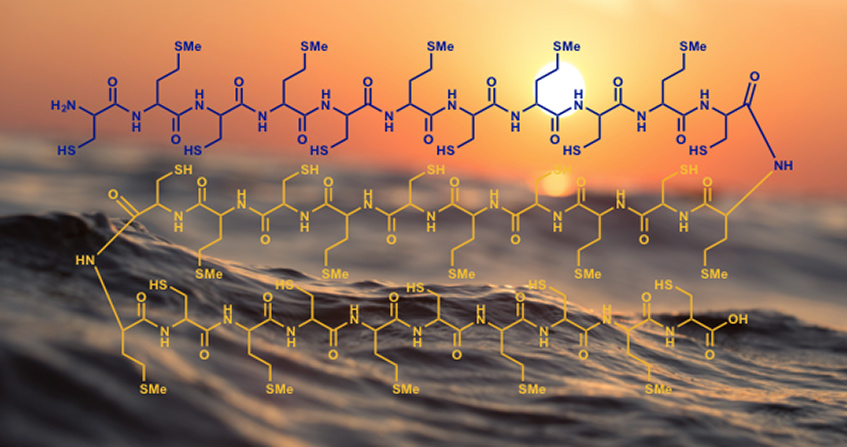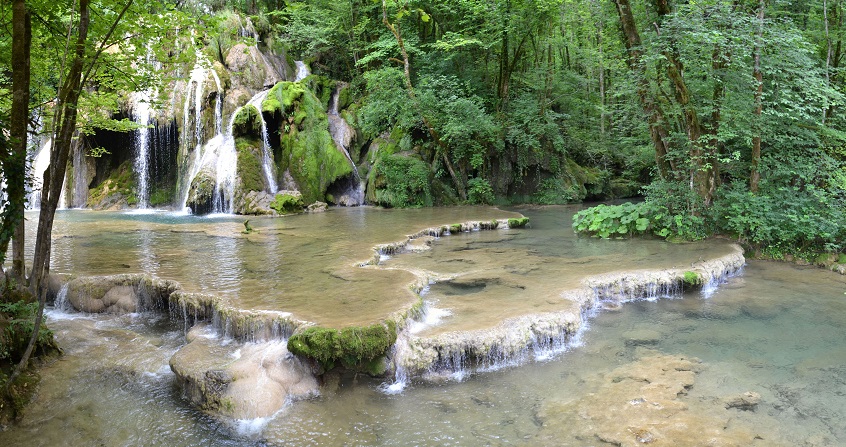一位天文学爱好者兼地质学家眼中的生命起源
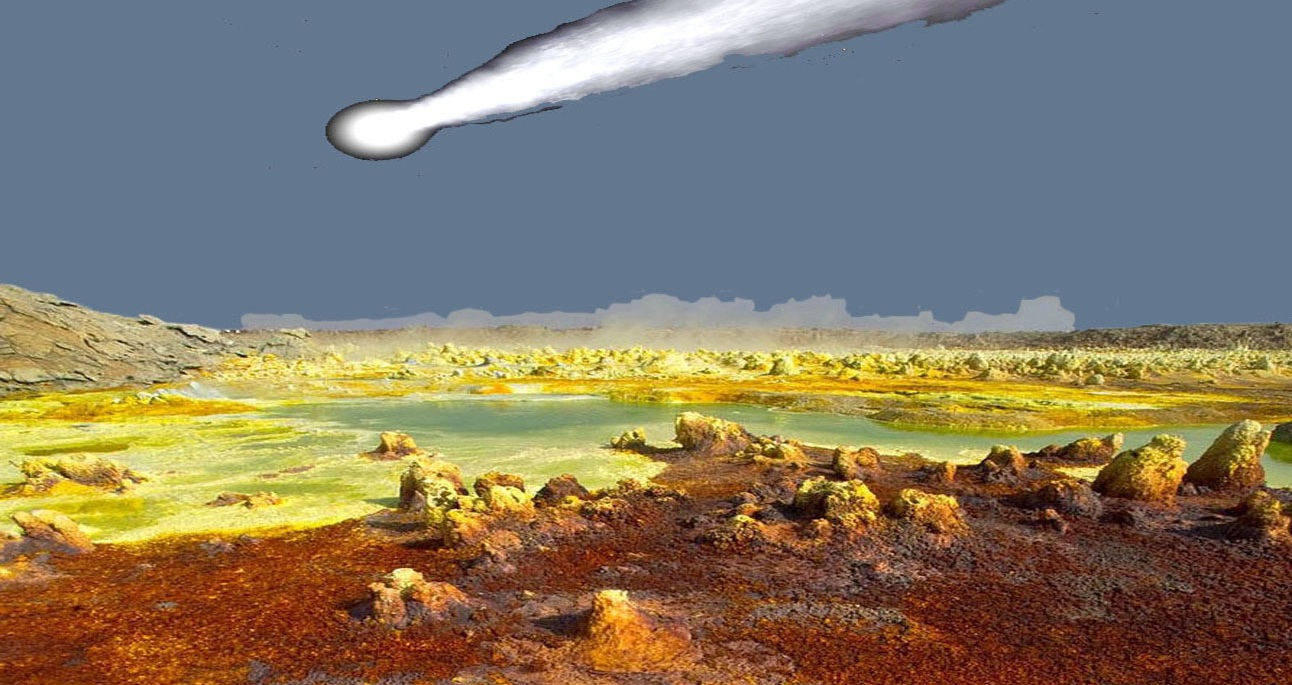
地球上的生命诞生于约40亿年前,即45.4亿年前地球形成后不久。虽然人们对复杂大分子到最简单细胞的过渡仍然知之甚少,但对二者起源的疑问要少得多。它们的基本成分自然合成于产生彗星和陨石的尘埃表面以及热水与富铁硅酸盐相接触的地壳岩石圈。然而,许多陨石和彗星在大约40亿年前落到了地球上,使得地球表面地表以下盛产富含硅(硅酸盐)和铁的矿物。
1.生命起源:细胞的故事
19世纪中期之前,并没有生命起源的疑问:生命是造物主的杰作。对于无神论者或批判性信徒来说,自发生成理论解决了这个问题:当环境合适时,生命(至少是简单的生物体)从矿物物质中自发出现。巴斯德在19世纪60年代证明,生物体的这种自发出现并未在与实验室实验相符的自然条件和持续时间下发生,于是生命起源这个问题变得至关重要。一百五十年后,我们如何总结这个问题?生命首先是一个细胞(见《第一批细胞的起源:工程师的观点》)。制造一个细胞在“概念上”很容易,需要3步,可通过回溯过去来描述。最近的一个步骤是细胞本身的形成。这需要复杂的有机大分子,如蛋白质、核酸这类聚合物,如果可能的话,要有自动复制(拷贝或复制自己的行为)和催化特性(分子(例如酶)进行化学反应的能力)。这些存在于溶液或悬浮于水中的大分子还必须组合在一起,形成或多或少具有渗透性的膜,并联结成实体,将内部环境与外部环境隔开。在这第三步之前,还需要第二步,即通过聚合较简单但已经相当复杂的碳分子,如氨基酸、含氮碱基、单糖,来制造这些大分子。而在这第二步之前,还需要第一步,即制造那些将要聚合但已经相当复杂的分子。因此,生命史上最古老的这一阶段包括从无处不在的简单分子(二氧化碳(CO2);水(H2O);氨(NH3);氰化氢(CNH)等)中合成氨基酸、含氮碱基,这些分子含有生命的主要成分:碳(C),氢(H),氧(O)和氮(N)。
2.地球上原始生命的化石证据
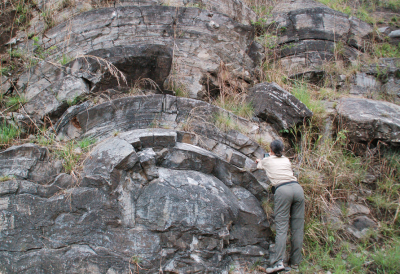
南非的精美层叠石,距今约30亿年前[来源:皮埃尔·托马斯(Pierre Thomas)摄]。
是否有任何关于生命起源的证据?要知道到哪里去找,首先要设法确定这三个阶段发生的环境、条件和时间。2016年的共识认为最古老的形态学痕迹可以追溯到35亿年前。这些间接痕迹发现于澳大利亚或南非的沉积岩中,表明存在细菌菌幕,也叫生物膜。以分泌粘性和保护性基质为标志的微生物群落。通常形成于水或水介质中。生物膜可能是最早的生物群落,通常是在浅水、海洋或淡水环境中产生的钙质结构。它们既是沉积物,也是生物源(由蓝藻群体建造)。叠层石是一种无生命结构,只有建造它的蓝藻细菌是有生命的。叠层石在35亿年前已经存在,遍布各大洲。其形态与目前的同类物质相当相似(图1)(见《生物圈,一个主要的地质角色》)。细菌细胞的残留物也是可以识别的,但其起源仍存争议。这些沉积岩也含有机物,富含12C,即碳的轻(和主要)同位素(一种化学元素的特殊形式。同一元素的同位素因中子数目不同而不同,但它们的质子和电子数目相同。)。然而,通过酶促过程(如本森–卡尔文循环(Benson and Calvin cycle))合成有机分子,可使有机物富集12C的比例与在这些古老岩石中发现的相同。目前还没有已知超过35亿年的形态学生命指标。但我们知道变质岩(温度和压力上升后经历了矿物学转变以及结构转变的岩石)显示了12C的富集。我们非常了解格陵兰岛的这些岩石,它们距今38亿年前。在澳大利亚发现了具有这种12C异常的最古老岩石(事实上是矿物),距今41亿年前,这表明在那个时候已经有了生物圈。生命出现在地球上的时候,大气和海洋都没有氧气(O2),地球仍然受到无数彗星和陨石的轰击,火山活动比今天更加活跃。正是在这样的背景下,必须发生生命起源的3个主要阶段。
3.生命起源三阶段
3.1.有机大分子形成细胞
地质学家并不具备理解第三步的最佳条件:即从聚合物和其他有机大分子制造细胞。这一步没有化石佐证,只能参考化学家和生物化学家的研究工作,而这些工作在2016年还远未完成。自20世纪初以来,实验(以及最近的建模)指出了可能路径以及可能发生的情况:将聚合物组成膜,膜转化为球状物,存在既具有催化特性又能进行还原反应(基于电子在一个氧化(失去一个电子)的分子和另一个被还原(获得一个电子)的分子之间转移的化学反应。)和传输其复制所需信息的RNA(核糖核酸,是由一连串的核糖核苷酸(腺嘌呤、胞嘧啶、鸟嘌呤、尿嘧啶)组成的分子,在细胞内具有许多功能。)。
3.2.通过聚合制造有机大分子
地质学家更关心生命起源的第二阶段:即通过聚合较简单的有机单体(如氨基酸、含氮碱基)形成这些大分子。事实上,这种聚合在很大程度上得益于催化剂,而地质学提供了这类催化剂:例如黄铁矿(FeS2)和层状硅酸盐(又叫片状硅酸盐,是由四面体层堆积而成的硅酸盐族矿物)等硫化物,主要为粘土和蛇纹石。这些矿物的表面具有吸附氨基酸等单体的特性,使其浓缩并强力聚合。硫化物在火山地带很常见,而在水与硅酸盐岩石,特别是构成岩石圈(地球的表面部分,由两个叠加的陆地层组成:地壳(海洋或大陆)和刚性上地幔。它在海洋以下的厚度为60至70公里,在大陆以下为100公里。)的玄武岩(来自快速冷却的岩浆的深色火山岩。)和脉石(超基性岩浆岩,构成了地球上层地幔的主要部分。)接触的地方会富集粘土和蛇纹石。因此,如果我们有一个“富含”氨基酸分子和其他有机分子的水介质(有时被称为“原始汤”),层状硅酸盐和/或硫化物,步骤2和3就可以“自发”产生原始细胞(细胞原型,初级细胞),继而成为第一批生物体。
3.3.形成“生命的分子”
氨基酸、含氮碱基和其他单体(复杂分子的基本成分。因此,氨基酸形成蛋白质,碳水化合物形成复合糖,核苷酸形成核酸)(有时被称为“生命的基本砌块”)的哪个(些)来源,是蛋白质、核酸和其他大分子等复杂聚合物发展的重要第一步?研究地球和太阳系的科学家们在这第一步的起源上提出了三种机制,三种彼此不兼容的起源。
大气起源。第一个起源说(按时间顺序)于1953年提出:源自米勒的著名实验[1]。当时,人们认为大约40亿年前的地球大气主要由甲烷(CH4)、氨(NH3)、氢(H2)和水(H2O)组成。外部能量供应(放电、紫外线光子等)足以产生更复杂的分子,如氨基酸(参见《生命出现的时候:40亿年前地球海洋的化学》)。但现在人们认为,地球的原始大气不包括H2,其碳主要是以CO2而不是CH4的形式存在。有了这样的大气层,合成物就不一样了,放电和紫外线几乎只形成过度氧化的化合物。因此,米勒的实验与地球无关。然而,不能排除在特定地点,例如在富含火山化合物的大气中,这种合成是可能的。这方面的研究仍在继续。
外星起源。彗星和陨石是生命分子起源的第二种可能(图2)。自1864年普雷德(Pride)(Tarn et Garonne)陨石坠落以来,我们知道一些陨石(碳质球粒陨石)被认为是太阳系最原始的陨石(其基本成分非常接近于太阳的成分)。它们的特点是富含碳、水和挥发性气体(特别是稀有气体)。含有这些著名的“生命的基本砌块”。20世纪60年代,这些有机分子被证明为陨石所固有,并非来自陆地上的杂质,这与普雷德陨石一落地就被提及(甚至被援引)的情况相反。一吨此类陨石含有60克氨基酸,相当于一个鸡蛋的质量,以及1.3克含氮碱基。
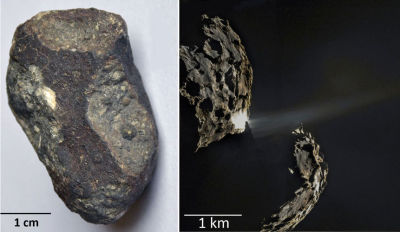
左图是碳质球粒陨石样本。这种陨石的碳含量高达5%,包括60ppm氨基酸(样品/照片:皮埃尔·托马斯(Pierre Thomas)摄)。右图是欧洲罗塞塔号(Rosetta)彗星探测器在2014年9月26日拍摄的67P-CG彗星(亦称丘尤穆夫·杰拉西门科彗星(Churyumov-Gerasimenko),或Chury彗星)的图像。[来源:照片© Esa,Rosetta,NavCam。分析结果(仍然是初步的)显示,这颗彗星富含有机分子]
通过光谱分析,可以在彗星尾部检测到简单有机分子。乔托(Giotto)探测器(1986年)和罗塞塔·菲莱(Rosetta-Philae)任务(2014-2016年)的原位分析证实了彗星中存在有机分子。很遗憾,菲莱着陆器无法对67P-CG彗星(亦称丘尤穆夫·杰拉西门科彗星(Churyumov-Gerasimenko),或简称Churi彗星)的尘埃进行分析。但是仅仅通过分析从这些尘埃中逸出的挥发性化合物,菲莱就发现了16种含碳分子,其中一些是氨基酸合成的前体(参见《如何研究彗星的有机分子》)。2006年,美国星尘号(Stardust)探测器带回地球的一个彗星颗粒中含有甘氨酸,这是一种最简单的氨基酸。罗塞塔(Rosetta)探测器搭载的“罗塞塔轨道器离子与中性粒子分析光谱仪”(Rosina)在Tchouri彗星尾部也发现了甘氨酸。当陨石或彗星碎片和尘埃到达地球时,大部分会因穿越大气层而被烧毁;但相当一部分会完整地到达地表。根据目前的陨石流和过去的陨石流(从月球研究中推断),以及这些物体的有机碳含量,我们估计有1015至1016公斤的有机分子在45亿至40亿年前到达地球而没有被破坏。这些地外有机分子被认为可以确定太阳系大部分的起源时间。太阳系前星云的外部尘埃(聚集成彗星和碳质球粒陨石的尘埃)一定富含水构成的冰和其他小分子(CO、CO2、CH4、NH3、CH3O等)。而当这样的冰混合物被紫外线光子或宇宙射线照射时,就会形成更复杂的分子,包括我们熟知的基本砌块。
地质学起源。海底和/或大陆底部土壤是有机分子形式生命起源的第三种可能。我们知道如何在适当催化剂存在下,在高温或中温环境中利用H2和CO2制取有机分子。
CO2 + 4H2 → CH4(和其他更复杂的分子)+ 2 H2O(费歇尔-托罗普施(Fischer-Tropsch)反应)
在NH3(氨)或HCN(氰化氢)存在下,可以合成氨基酸和含氮碱基(斯特雷克(Strecker)反应)。然而,当不太冷的水(T≥80℃)与含有Fe2+形式铁的硅酸盐(橄榄石、辉石等)接触时,会发生一种反应,其类型可以用以下反应式来概括:
橄榄石+H2O →蛇纹石+青铜矿+磁铁矿+H2
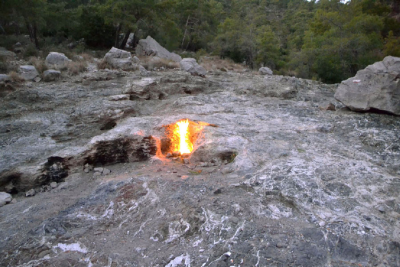
这个被命名为“La Chimère”的地点证明了诸如费歇尔-托罗普施(Fischer-Tropsch)反应等有机合成反应的真实性,因为它们如今就发生在土耳其的地下土壤中[来源:皮埃尔·托马斯(Pierre Thomas)摄]。
因此,只要水(海水、地下水等)与热橄榄岩等富含橄榄石的岩石接触,就可以合成H2(图3)。这一反应产生磁铁矿(Fe3O4)和蛇纹石。然而,磁铁矿是一种催化剂,可以促进费歇尔-托罗普施(Fischer-Tropsch)反应。此外,氢氧镁石(Mg(OH)2)保持的碱性环境促进了斯特雷克(Strecker)反应。而事实证明,蛇纹石是一种非常好的有机单体聚合催化剂。因此,这些水与热橄榄石接触的地点具有生命出现的“一切条件”:典型的氨基酸单体,以及使其聚合的催化剂。其他两种假设机制(由陨石或彗星带来的单体,或在大气中合成然后落到地面上)需要另一个条件:就是它们已经到达了一个富含层状硅酸盐的地理区域。但是,层状硅酸盐并不鲜见。
4.生命起源的结论和展望
所有上述情况都强烈表明,生命起源是一种“相当容易”实现的自发现象,因为无需任何特殊条件;生命在地球上出现的“速度”加强了这种印象。显然,“容易”和“快速”这两个词必须从地质学角度来理解。“快速”是指生命出现的时间距今不到4亿年,或者说不到地球历史的8%。而“容易”必须理解为,当一个难题“快速”完成时,它就是“容易”的。所有这些也表明,只要有液态水、陨石和彗星降临和/或水与橄榄石或辉石接触,就可能出现生命。这样的地点在太阳系中并不少,特别是火星、欧罗巴(木卫二)、恩克拉多斯(土卫二),更不用说无数的太阳系外行星。未来的研究将告诉我们到底发生了什么!至于火星、欧罗巴和恩克拉多斯,“只是”去现场看看的时间问题,因为从地球上使用空间探测器就可以到达。对于太阳系外的行星,在可预见的未来无法进行原位研究,只能研究其大气和表面的光谱。尽管在2016年我们的仪器探索能力仍然不够,但最容易的探索途径之一就是在一个系外行星的大气层中寻找高氧化性(如O2)和高还原性(如CH4)化合物的光谱线是否共存。这种共存将证明该大气层中存在着强烈的化学不平衡。而生命是这种化学不平衡的一个巨大成因!
参考资料和注释
[1]Miller SL & Urey HC (1959) Organic Compound Synthesis on the Primitive Earth, Science, 130, pp. 245-251.
环境百科全书由环境和能源百科全书协会出版 (www.a3e.fr),该协会与格勒诺布尔阿尔卑斯大学和格勒诺布尔INP有合同关系,并由法国科学院赞助。
引用这篇文章: THOMAS Pierre (2024年3月7日), 一位天文学爱好者兼地质学家眼中的生命起源, 环境百科全书,咨询于 2024年4月20日 [在线ISSN 2555-0950]网址: https://www.encyclopedie-environnement.org/zh/vivant-zh/origin-of-life-seen-by-geologist-who-loves-astronomy/.
环境百科全书中的文章是根据知识共享BY-NC-SA许可条款提供的,该许可授权复制的条件是:引用来源,不作商业使用,共享相同的初始条件,并且在每次重复使用或分发时复制知识共享BY-NC-SA许可声明。







